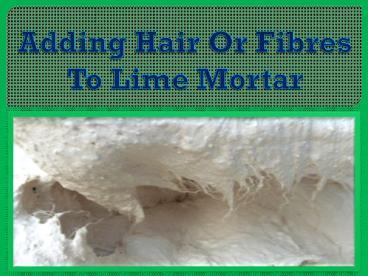Adding Hair or Fibres to Lime Mortar - PowerPoint PPT Presentation
Title:
Adding Hair or Fibres to Lime Mortar
Description:
Hair or Fibres have traditionally been used as reinforcement in lime renders as a means of improving tensile strength and to reduce shrinkage cracking. Introduced into the mix by teasing the hair into the mix prior to the mortars use. This is a time-consuming job as it involves teasing the hair into the mix as it is mixed. Clumps of hair simply cannot be placed into the mixer as they will remain in the mix as large balls of hair and will not part no matter what type or method of mixing is used. – PowerPoint PPT presentation
Number of Views:33
Title: Adding Hair or Fibres to Lime Mortar
1
Adding Hair Or Fibres To Lime Mortar
2
Hair or Fibres have traditionally been used as
reinforcement in lime renders as a means of
improving tensile strength and to reduce
shrinkage cracking. Introduced into the mix by
teasing the hair into the mix prior to the
mortars use. This is a time-consuming job as it
involves teasing the hair into the mix as it is
mixed. Clumps of hair simply cannot be placed
into the mixer as they will remain in the mix as
large balls of hair and will not part no matter
what type or method of mixing is used.
3
(No Transcript)
4
(No Transcript)
5
The use of hair in renders is most definitely
advised on walls with a lath background. Hair
should be added to the first two coats but not
the final setting coat. As for its use on a solid
masonry background this is somewhat questionable
(in our opinion) but does act as a good
reinforcement by reducing the amount of shrinkage
cracking in thick coats of render.
6
(No Transcript)
7
(No Transcript)
8
Cornish Lime supply a range of types of hair
along with polypropylene / flock fibres and can
give guidance on the quantities needed. We also
supply CLM28F, a ready-mixed lime putty mortar
with the addition of fibres included
9
(No Transcript)
10
(No Transcript)
11
Fibres Vs Animal Hair
12
Fibres work nearly as well as natural animal hair
but are cheaper and far easier to introduce into
the mix. Rather than teasing in as for hair,
simply sprinkle the fibres into the mix. This
then requires only a few minutes mixing for them
to be thoroughly distributed.
13
(No Transcript)
14
The hair used would be any animal hair, rough in
texture from goats, cows, horses (body hair not
the mane or tail) amongst others. Evidence of
other types of reinforcement has been found which
include hemp or jute fibres among others, but the
use of hair is fairly universal for this role
15
(No Transcript)
16
For more update , visit us
https//limetec.co.uk/hydraulic-lime-mortars/































